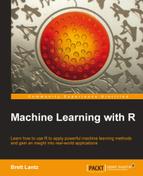- Machine Learning with R
- Table of Contents
- Machine Learning with R
- Credits
- About the Author
- About the Reviewers
- www.PacktPub.com
- Preface
- 1. Introducing Machine Learning
- 2. Managing and Understanding Data
- R data structures
- Vectors
- Factors
- Managing data with R
- Exploring and understanding data
- Exploring the structure of data
- Exploring numeric variables
- Measuring the central tendency – mean and median
- Measuring spread – quartiles and the five-number summary
- Visualizing numeric variables – boxplots
- Visualizing numeric variables – histograms
- Understanding numeric data – uniform and normal distributions
- Measuring spread – variance and standard deviation
- Exploring categorical variables
- Exploring relationships between variables
- Summary
- 3. Lazy Learning – Classification Using Nearest Neighbors
- 4. Probabilistic Learning – Classification Using Naive Bayes
- Understanding naive Bayes
- Example – filtering mobile phone spam with the naive Bayes algorithm
- Summary
- 5. Divide and Conquer – Classification Using Decision Trees and Rules
- Understanding decision trees
- Example – identifying risky bank loans using C5.0 decision trees
- Understanding classification rules
- Example – identifying poisonous mushrooms with rule learners
- Summary
- 6. Forecasting Numeric Data – Regression Methods
- Understanding regression
- Example – predicting medical expenses using linear regression
- Understanding regression trees and model trees
- Example – estimating the quality of wines with regression trees and model trees
- Summary
- 7. Black Box Methods – Neural Networks and Support Vector Machines
- 8. Finding Patterns – Market Basket Analysis Using Association Rules
- 9. Finding Groups of Data – Clustering with k-means
- Understanding clustering
- Clustering as a machine learning task
- The k-means algorithm for clustering
- Finding teen market segments using k-means clustering
- Step 1 – collecting data
- Step 2 – exploring and preparing the data
- Step 3 – training a model on the data
- Step 4 – evaluating model performance
- Step 5 – improving model performance
- Summary
- Understanding clustering
- 10. Evaluating Model Performance
- 11. Improving Model Performance
- 12. Specialized Machine Learning Topics
- Index
Machine learning originated at the intersection of statistics, database science, and computer science. It is a powerful tool, capable of finding actionable insight in large quantities of data. Still, caution must be used in order to avoid common abuses of machine learning in the real world.
In conceptual terms, learning involves the abstraction of data into a structured representation, and the generalization of this structure into action. In more practical terms, a machine learner uses data containing examples and features of the concept to be learned, and summarizes this data in the form of a model, which is then used for predictive or descriptive purposes. These can be further divided into specific tasks including classification, numeric prediction, pattern detection, and clustering. Among the many options, machine learning algorithms are chosen on the basis of the input data and the learning task.
R provides support for machine learning in the form of community-authored packages. These powerful tools are free to download, but need to be installed before they can be used. In the next chapter, we will further introduce the basic R commands that are used to manage and prepare data for machine learning.
-
No Comment
